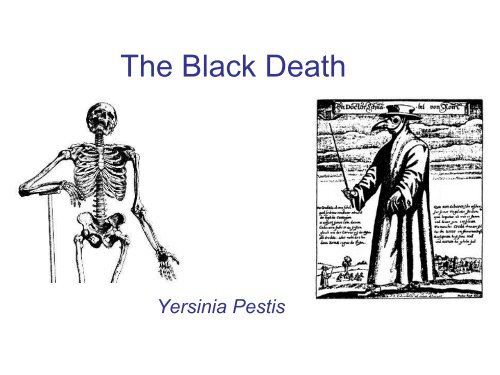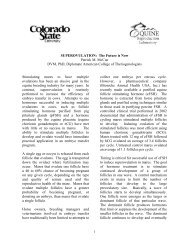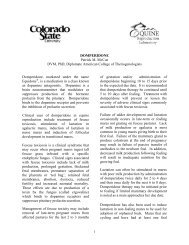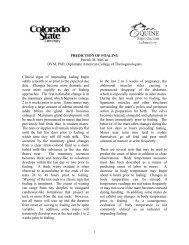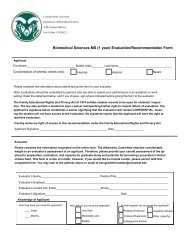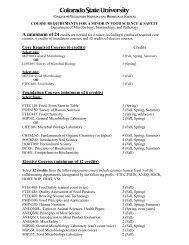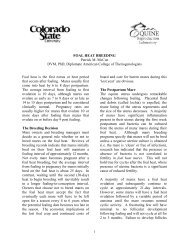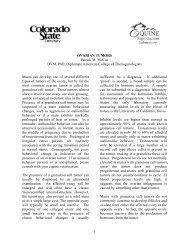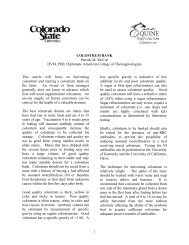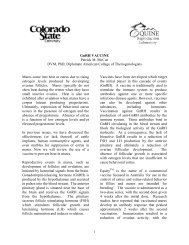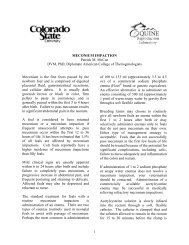The Black Death
The Black Death
The Black Death
You also want an ePaper? Increase the reach of your titles
YUMPU automatically turns print PDFs into web optimized ePapers that Google loves.
<strong>The</strong> <strong>Black</strong> <strong>Death</strong>Yersinia Pestis
Mortality‣Total body count? - ~200MM deaths‣<strong>The</strong> <strong>Black</strong> <strong>Death</strong> is one of the greatest catastrophes of human disaster,second only to WWII in terms of mortality‣Used by US Atomic Energy Commission to model outcomes of nuclearwar given scale of casualties…!‣We will never really know just how many died..‣1347-1352 – 25MM of 75MM inhabitants of Europe?‣in some places (England, France) mortality was 50-60% in places‣1994 – 2003 – WHO 28,000 cases, 2000 deaths‣2006 USA 13 cases, 2 deaths – NM, Col, Cal, Texas‣2 cases in trappers skinning rabbits‣Congo – 2005 – 114 cases, 54 deaths‣Only limited by everyone else fleeing the area in panic
Why Yersinia?Bacterium discovered in the 3rd plague 1890’s China and IndiaAlexandre Yersin, trained in Switzerland [studied the methods of RobertKoch], working in Hong Kong, discovered Yersinia pestis
Three forms of disease‣Enzootic in rodents‣Sometimes spreads into human, usually by flea bites‣Most cases are bubonic – lymph nodes‣Some are septicemic – blood‣Or pneumonic – get into lungs – highly infectious‣Human – human transmission‣Pneumonic form – consisting of infected droplets inhaled by closecontacts‣Symptoms seen in ~3 days, death in ~6 days
“Bubonic plague”‣Classical symptom of plague is the “buboe”‣Swollen lymph node in groin or armpit‣Occasionally spreads into the blood – septacemic form‣Can erode into lungs – pneumonic plague--v. rapidprogression and death in 1-3 days
Yersinia pestis‣Gram negative, facultative anaerobes‣Non-motile coccobacillus‣“Safety pin” morphology – blue polar bodies‣Catalase+, oxidase negative‣Bluish/red cytoplasm‣Non-hemolytic‣Capable of growing over a range of temperatures
Pathogenesis‣Genome of Y.pestis + 3 plasmids published in 2001‣Evolved from Y.pseudotuberculosis ~20,000 years ago by acquiring 2virulence plasmids, enabled fleabite transmission‣Low-calcium response plasmid pYV or pCD1‣Additional plasmid pFra‣Encodes capsular protein and other toxins that ensure rapid growth inmonocytes/macrophages and the generation of necrosis‣Y.pestis has evolved to reach v. high concentrations in rodent blood sothat fleas ingest as many as 10 4 when feeding ~0.1ul‣Switches acylation of its lipid-A molecule when moving from flea (26oC) tohumans (37oC)‣Forms a tetra-acylated lipid-A which binds TLR4 on human macrophagesbut does not signal
Dig ‘em up and ‘ave a look….~5th Century graveyard, Sens, France --?Justinian plague12-14C Dreux, France (dated from ceramic fragments) <strong>Black</strong> <strong>Death</strong>
Three epidemics, three biovars‣3rd Epidemic-1894 Burma – China – HK – India‣10MM deaths in India over next 20 years‣Three biovars -Antiqua (East Africa)‣ Medievalis (Central Asia)‣ Orientalis (3rd pandemic)‣Can be distinguished by ability to ferment glycerol‣All are virulent in animal models
Plague in the USA‣First US outbreak 1900 – 1904 Port of San Francisco ?‣Various outbreaks along Pacific coast through 1925 ~490 cases‣Gradually plague became established in wild rodent populations, andthis spread across the Western States‣<strong>The</strong> “Plague Line” Oklahoma, west Kansas, west Wyoming‣Spread slowed/halted by “active surveillance”
US outbreak vectors‣Cases in US associated with multiple hosts – squirrels, rabbits,prairie dogs, deer mice, chipmunks, wood rats‣-20 cases in past 30 years traced to domestic cats
TreatmentGentamycinStreptomycin – highly effective (1950-90), still used in parts of AfricaDoxycyclineTimethoprim-sulfamethoxazole (efficacy still not clear)New fluoroquinolones – ciprofloxacin now recommendedTetracyclineChloramphenol
Not a very good bioweapon‣Not sporulating, doesn’t survive well outside people/animals‣Nobody figured out how to aerosolize‣“Bioterror use greatly exaggerated”
Rats everywhere‣Poverty (housing that is not rat-proof)‣Hot weather (exposed feet, legs)‣War …….refugees – garbage – rats
Vectors‣When rats die of plague, fleas jump to new host and this can behumans‣Human not vector of choice because humans are poortransmitters (and then only of pneumonic form)‣<strong>Black</strong> rat – Rattus rattus‣Brown sewer rat – Rattus norvegicus‣Primary flea vector is Xenopsylla cheopsis (oriental rat flea)‣When flea has blood meal containing Y.pestis this causesblockage of the digestive tract; this allows the bacilli to form biofilmson the gut surface‣Flea tries to clear gut by repeated biting and regurgitation of thebacteria
Flea to human transmission‣Flea blood meal blocks the foregut‣Yesinia hms locus encodes proteins that bind to flea haemin as well aspromoting bacterial aggregation by increasing the hydrophobicity of thebacterial cell wall; this clumping blocks the foregut‣Dose delivered by flea bite ? ~20,000 bacilli ?‣Neutrophils kill bugs, macrophages don’t (still not clear why)--PhoP/PhoQsystem implicated‣Massive inflammation causes huge influx of cells into the lymph nodes,causing the characteristic “buboes”‣Bacteria have type-III secretion system that inhibits phagocytosis – this isupregulated as the disease progresses‣This allows entry of effector proteins (Yops) into the host macrophagewhich inhibits the cell cytoskeleton, down-regulates the inflammatoryresponse, and induces macrophage apoptosisY.pestis has a “remarkable ability to survive and grow in a diversity ofhost environments”
Traveling flea circus‣Latin: rodere “to gnaw”‣Rats can travel significant distances looking for food.‣R.rattus can jump up three feet, climb almost anything, squeezethrough very small openings‣Xenopsylla itself however can survive several miles, traveling onhorses, carts, etc, and could live as much as 6 weeks before needing ahost‣When epidemics spread, and rats die, fleas look for another carrier, andas a result surviving rats can carry as many as 100-200 fleas..
Thank you, China?‣<strong>Black</strong> <strong>Death</strong> seems to have arisen in Mongolia/Kirqizia andprobably would have stayed there if not for the decision of theMongols to try to unify Eurasia in the 13th century.‣Trade, travel – both facilitate the spread of diseases‣<strong>The</strong> “Yam” the Mongol version of the pony express
<strong>The</strong> original flea vector?‣Tarabagan‣Marmota sibirica‣Siberia, Mongolia, NW China‣Marmot-like animal‣Harbors/dies from plague‣Primary target of USSR biological weapons program [Nikolai Urakov“get me the tarabagan plague…”]‣‣Marco Polo – “there are a great number of Pharaoh’s rats in burrows onthese plains”
Fauna disruption‣Environmental stress, earthquakes, etc in early 14th Century‣Disrupted wild rodent communities – driving them towards humansettlements in search of food and shelter….‣People living in crowded conditions – the filthier the better!‣<strong>The</strong> 3rd plague, a century ago, failed to spread beyond India/Chinabecause the above conditions had been dealt with
Spreading WestRest stops for caravans traveling across the Gobi desertLake Issyk Kul (a thermal spring) – a possible site of the initial origins ofthe plague1910 outbreak of plague in Manchuria – 60,000 deathsCaused by surge in prices for tarabagan fur – this attracted inexperiencedhunters who captured animals already sick from Yersinia
“this is the end of the world…”In the 1340’s the plague arrived inEurope“Wild dogs paw at the newly dug gravesof the plague dead”Corpses, packed like “lasagna” inmunicipal plague pits…<strong>The</strong> collection carts winding throughstreets to pick up the previous day’sdead…Husbands abandoning dying wives,parents abandoning dying children – forfear of contagion…Knots of people crouched over latrinesand sewers inhaling the noxious fumes inhopes of inoculating themselves againstthe plague…Roads packed with panickedrefugees…ghost ships crewed bycorpses…
East meets West‣Genoa was on of the most powerful “City-States” in what we now call Italy(“God was born in Genoa”)‣1266 Genoese arrived in Caffa (now Feodosiya) on the east coast of theCrimea and established an elaborate city and trading center (they paid off theMongols to do so)‣Silks from Asia, sturgeons from Russia, slaves from the Ukraine, timbers, andfurs.‣Caffa well situated – the steppes to the north from which one could reachChina in as little as 8-months‣To the west, Constantinople, and the trading regions of the Levant (Ukraine)‣-three rivers… Volga, Don the the east, Drileper to the west‣First to hear rumors of “environmental upheaval” in China in the 1330’s-bigearthquake, droughts, then monsoons
<strong>The</strong> siege of Caffa‣1331 – an epidemic swept Hopei province “killing 90% of the population”‣In 1332 the Mongol Khanate Toq-Temur and his sons died suddenly of amysterious illness‣Tensions between the Mongols (Islam) and Caffa grew, and a small incident(brawl in the market) in Tana, near the mouth of the Don, resulted in theMongols laying siege to Caffa in 1343‣~1346 plague spread down the Volga and Don, reaching Caffa, which wasstill under siege –‣Khan Janiberg – “the father of modern biowarfare”! -- the Tartar army tookdead bodies and flung them into the city using catapults. Although this mayhave contributed, the spread of disease was due to the usual reason– therats..‣By ~April 1347 most of the Tartar army was dead and the inhabitants ofCaffa in no better shape-some escaped by boats in the harbor – taking therats with them“rodents and their fleas, that once would have died a lonely death on aSiberian prairie…now transported by caravans, soldiers, Mongolriders…to far away places…”
Bringing the plague to SicilyIn October 1347 -- 12 Genoese galleys put into Messina. Most of the crewwere already dying, and within days the locals did too“a sort of boil…the size of a lentil, erupted on a thigh or an arm, then thevictims coughed up blood… and after three days of vomiting…for whichthere was no remedy…they died…and with them died not only everyonewho had talked to them, but also anyone who acquired, touched, or laidhands on their belongings” [Friar Michele of Messina]How did the galley’s get as far as Messina? Did they really come from theCrimea, or (more likely) from closer ports.Some Genoese are now known to carry a mutation in the chemokinereceptor gene CCR5--which might increase survival times?
Into Europe…….‣Around 1340 the plague had spread to the trading outposts in theCrimea run by the Italians--once there, sailing vessels spread thedisease relentlessly across Europe‣September 1347 Genoese sailors fell off boats in Sicily with“sickness clinging to their very bones…”‣March 1348 much of central and northern Italy was infected,including Genoa, Florence and Venice.‣By Spring 1348 – Spain, Southern France, the Balkans‣Summer 1348 – Northern France, England, Ireland‣Autumn 1348 – Austria, parts of Germany‣1349/50 – Scotland, Denmark, Portugal‣“In a century which nothing moved faster than the fastesthorse, the plague had circumnavigated Europe in less than fouryears”
What does the queen command?
What does the queen command?‣To prevent the evil miasmas, spread garlands of flowers andgarlic around the affected houses‣Send troops to quarantine the area; let nobody out‣Too late….dun a runner‣Burn down the houses where people are sick
What does the queen command?‣To prevent the evil miasmas, spread garlands of flowers andgarlic around the affected houses‣Send troops to quarantine the area; let nobody out‣Too late….dun a runner‣Burn down the houses where people are sick
What does the queen command?‣Kings/Queens/high officials fled to the country‣Pope Clement VI fled Avignon (seat of the medieval church)‣His physician Guid de Chauliac, remained to treat the sick
No outdoor plumbing‣By the 14th C – population had grown, almost to point ofoverpopulation relative to the available resources‣<strong>The</strong>n, in 1315-1322 it was unusually rainy, destroying crops, andcausing starvation in Italy and elsewhere.‣<strong>The</strong> medieval city was often a human cesspool of “People, rats,fleas, garbage, flies and waste”!‣“Rue Merdeux” and so on was popular (merde!)‣Most cities had an outdoor slaughter house‣“Look out below” cried three times before dumping the chamberpot
Take a bath? You can’t be serious…?While the Greeks and Romans considered cleanliness and hygiene soimportant, early Christians considered bathing almost a sin.People in Europe rarely, if ever, changed their clothing (when Thomas aBecket was assassinated – his body was stripped and found full of fleas)Edward-III “scandalized London” when he bathed three times in threemonths…“Cloth the wicked, inhale fragrances, and pray…”
Things looking up…‣Early Middle Ages (6-9th C) -- collapse of civilization, a decrease in theEuropean population, and for this reason less transmission of infectiousdiseases in general‣Great surge in forestation – a natural firewall!‣Trading routes East not explored -- “in unfriendly Muslim hands”‣<strong>The</strong> “Little Optimum” 750-800…a period of global warming [vinelands inGreenland!]; conditions began to reverse themselves -- 1000-1250 thepopulation doubled. Farms thrived, good crop yields; innovations in farmingappeared --horse-collars, carruca plow blades, windmills.‣City populations exploded; forests started to get cut down; swamps drained;pastures cleared; villages erected.‣Christians began to drive Muslims out, particularly from Spain [1212]. As aresult, trade was revived and expanded.
…and then down again…‣In the 1320’s in England things then went awry --crops failed, price ofwheat and barley went up.‣Increased poverty across much of Europe‣“<strong>The</strong> Great Famine” -- attributed to the “Little Ice Age” starting ~1300‣Summers became cooler and wetter. In 1315 torrential rains across N.Europe wrecked crops‣1316 UK peasants “ate bird dung, family pets, mildewed wheat and corn”.Prisoners killed and ate each other‣Piracy increased‣May-June 1316 the rain was relentless; rinderpest outbreaks in domesticfarm animals‣All this raises the possibility that children that survived the famine weremore susceptible to infectious diseases [and plague was around the corner]
Fragmented Italy‣In 1347-1348 plague spread across Italy, but much of the country wasalready in disarray…‣Genoa was constantly at war with Venice‣<strong>The</strong> Papacy with the Holy Roman Emperor‣Naples at war with Hungary‣Clan warfare in Rome (Colonna versus Orsini)‣In no shape to resist a sudden and severe epidemic!‣Plague reached Genoa itself at the end of 1347. Knowing it was coming –galleys arriving were turned away from the harbor (one probably docked inMarseille instead)‣More came, and on New Years Eve 1347 plague entered the city
Plague pits…<strong>The</strong> plague pits of Florence….“such was the multitude of corpses…huge trenches were excavated in thechurchyards, into which new arrivals were placed in their hundreds, storedtier on tier like ships’ cargo, each layer of corpses being covered with athin layer of soil until the trench was filled to the top…” [Boccaccio]About half of Florence’s 100,000 population died…
Roman lunacy‣In 1309 the Papacy fled to Avignon leaving Rome with no civic order,and a battleground between two aristocratic families (Colonna, Orsini)‣By 1347 the city was a squalid ruin of ~35,000‣A young notary Cola di Rienzo talked the Pope into making him “Rectorof Rome”, and in May of 1347 he led a small army into the city andseized the municipal district. Throughout the summer he put on variousceremonies of increasing magnificence, declaring himself the “Tribune ofRome”‣<strong>The</strong> Pope (fearing he had upset the real power in Rome) pulled hissupport, but Cola had a further trick up his sleeve, and had members ofthe Colonna and Orsini families arrested. He signed orders to executethem, but when the morning came, he lost his nerve.‣With the plague approaching Rome, Cola’s cavalry killed a prominentmember of the Colonna family. Cola fled to a monastery in Abruzzi, justas the plague struck Rome, killing half the population.
Entrez La Belle France‣<strong>The</strong> plague arrived in Marseilles in November 1347.‣<strong>The</strong> port was an conduit for trade with Spain and the Levant (what todayis Turkey, MidEast, N. Africa coast), and the main port of departure forCrusaders‣It is thought that Marseilles was possibly the origin of the “Jewish plot” tospread plague across Europe “-contaminating wells with a plague poison”,although the citizens themselves were very tolerant to Jews.
Clement and Joanna‣In May 1348 Pope Clement sold Avignon for80,000 crowns to Queen Joanna of Naples and Sicily(1343-82). <strong>The</strong> price was thought to be rather low,and there is doubt any money actually changedhands at all‣Clement had just absolved Joanna of anyculpability in the death of her Hungarian husbandPrince Andreas‣Andreas was a “plump, dull boy” while Joanna wasbonking everything in sight. His relatives killed her in1382 in revenge‣Clement certainly liked to party, driving the Papacyto previously unheard of levels of profligacy andcorruption…”my predecessors did not know how to bepopes‣Half of Avignon died from the plague. Clement,choosing not to comfort his flock, dun a runner.
Into Paris…In May 1348 the plague approached Paris. <strong>The</strong> King, Phillip VI, while abrave soldier (he challenged Edward III to single combat at the battle ofParis in 1346) ran for it. He did not reappear for several years, returningto cuckold his son’s bride-to-be!By 1349 Paris had run out of burial space…
Check your horoscope today?When the plague reached Paris – the University of Paris Medicalfaculty said the cause was……an unusual conjunction of Saturn, Mars, and Jupiter…
Don’t smell the pee, look to the stars…An early 13th Century medical tract stated that the medical technology ofurinalysis could be dispensed with….because astrology had made thetechnology obsolete.…..corrupt of infected air…a deadly corruption due to the conjuction of Marsand Jupiter……Jupiter, being wet and hot draws up evil vapors which…Marsignites…..
England, 1348‣In 1348 England was in good shape. <strong>The</strong>y had once again beaten upthe French, with all the attendant war booty. (“there was no woman of anystanding who had not her share of the spoils of Calais…”)‣Edward II [a useless King] had been deposed by the English nobility in1327 who did not like his homosexuality and killed him (it is said) bypushing a hot plumber’s iron up his anus -more sane historians think hejust died of natural causes‣Edward III – a strong handsome man succeeded him.
Edward III‣Became King at 14, and at 17deposed Roger Mortimer [who hadhimself removed Edward-II‣‣Edward III was a formidable king‣Military became highly organized‣Encouraged the emergence of theEnglish parliament‣Succeeded by Richard-II [hisgrandson] in 1377
More sheep than people….In England, farming was good, there were more sheep than people,and the stirrings of an industrial society was beginning – coal, tinmining, ship building..<strong>The</strong>n, in the summer of 1348, everything went to hell…One news came straight huddling on anotherOf death and death and deathTwo years later, England’s population was cut in half.
Into England<strong>The</strong> plague entered England in July 1348 via the port of Melcombejust north of Weymouth – within a month, everyone there was deadBy September it was in London, killing Edward III’s daughter Joan
<strong>The</strong> Second Wave…‣In August 1348 a boat, possibly from Gascony, docked in Bristol --becoming the second entry point of the plague in England‣<strong>The</strong> disease spread rapidly, taking advantage of the newly built roadnetworks that led to the Midlands as well as London‣Priests were dying everywhere – so the Bishop of Shrewsburypronounced that deacons could administer the sacrament (a majorchange!) – and then immediately dun a runner to his rural manor.‣Things got even worse – rinderpest and fluke decimated the sheepherds‣By the end of 1348 half of the population of Winchester (the ancientcapital) were dead. People wanted to dig a plague pit outside the city butthe Bishop forbade this – since those buried in non-consecrated groundwould miss the Resurrection.
Fair London town‣In the winter of 1348 manpower shortages escalated and labor costs exploded‣Meanwhile farm animal prices plummeted – this was because when a tenantdied, his horse went to the Lord of the manor. Soon, they had so many theydidn’t know what to do with them, so they were dumped on the open market,depressing prices.‣At this time London was a major city – crowded, filthy with the Thamesthrobbing with life and goods --spices from Italy, wine from Gascony, silks fromSpain, linen from France, timber, iron, wax from Scandinavia‣And lots and lots of rats…‣In December 1348 Edward III fled, and in January 1349 cancelled Parliament
You can’t beat us at Football either…….In 1349, Scotland loved all this, and in March 1350 amassed an army atSelkirk, only for the plague to arrive even before the English army.
Buried carefullyIn 1985 a plague pit was dug up in London --showing rites were preserveddespite the carnage…-many of the dead were in caskets or shrouds-all were side by side, heads to the west, feet to the east often segregated byage and gender
Decline of the Land Barons‣After the plague had subsided, the landed gentry saw their wealthshredded by low food prices and high labor costs‣Peasants saw their labor increase in value‣Serfdom began to disappear entirely‣A man could simply move to another manor knowing he would be hired,plus he could negotiate to prevent death taxes and such like.‣By 1450 peasants could often leave a parcel of land to each of theirchildren‣Some Lords abandoned their lands, renting them out to increasingprosperous peasants, who moved to farming animals rather than crops
Not so fast, mate‣Edward-III tried to counteract these changes by new laws and taxes.1351 – Statute of Labourers --pegging wages to pre-plague levels‣This resulted in 1381 in the “Peasant Revolt” [Richard now on thethrone]‣Hard to enforce -- May 30th 1381 Poll Tax collectors were driven fromvillages in Essex
<strong>The</strong> peasants meet the King, sort of..In June 1381 Wat Tyler led rebels on a march onLondonAnother mob, led by Jack Straw of Essex, alsoapproachedA further mob stormed the Tower of London, killingthe Archbishop of Canterbury and the LordTreasurer<strong>The</strong> following day, at Smithfield, Wat Tyler and hisfollowers met the King [Richard-II] and hisdelegation. Tyler got off his horse, spoke rudely tothe King, and apparently drew a dagger, at whichpoint William Walworth, the Mayor of London,drew his sword and killed him. Tyler’s followers didnot see this in the melee, and the King told themhe would knight Tyler at nearby St. Johns Fields.<strong>The</strong> rebels left, the nobles called out their militia,went to the fields, killed several other leadersincluding Straw, and dispersed the rest.
God’s will…..‣“<strong>The</strong> punishment of a wrathful creator”‣Sept 1340 – Edward III “a just God now visits the sons of men…”‣<strong>The</strong> influential English monk Knighton said God was pissed because of“tournament groupies” and general “abject malfeasance”‣Evil doers spreading poisons…guess who? - <strong>The</strong> Jews -- violent antisemitism…‣<strong>The</strong> Flagellants…flailing their half-naked bodies to appease God whileslaughtering Jews whenever the opportunity arose
<strong>The</strong> Jewish Plot‣By 1348 it was widely believed that the plague was not an act of God, but aJewish conspiracy aimed at achieving world domination‣<strong>The</strong> Swiss town of Chillon started the rumor of “Rabbi Jacob”, themastermind, and a network of Jewish agents spreading across Europe‣<strong>The</strong> Jews held in a small bag or package, the poison was made fromlizards, frogs, and spiders, ground up with the hearts of dead Christians andHoly wafers‣All this a variant on an earlier rumor that lepers spread the disease, paid byJews in league with the Muslim Caliph (sounds a bit like Glenn Beck)‣Between the summers of 1348 and 1349 a large number of Jews were killed‣-marched to public bonfires, burned at the stakes, beaten to death, orstuffed into empty wine caskets and rolled into the Rhine‣While this swept across France and Germany and Switzerland Marseillesremained a small pocket of tolerance, the 2500 Jews in the city were leftunharmed
Jew burningGermany 1349 – Jews were herded onto an island on the Rhine inBasel, and burned. In Stratsburg they were marched to a cemeteryand burned alive – the locals thinking this would save them from theplague.In Worms, Jews locked themselves in their homes and set light tothem, preferring death to being forced to become Christian.
Naughty spanking‣<strong>The</strong> Brotherhood of the Flagellents and the Bretheren of the Crossarose in Germany during the <strong>Black</strong> <strong>Death</strong>‣<strong>The</strong>y actually began with an anti-clerical message – that priestswere unnecessary for salvation – a further aspect of disillusionmentwith the Church‣However soon became inflated with their own self-importance as “amighty host of glorious Saints with divine powers…”
‣Disrupted Masses, drove priests from churches andlooted them, and killed Jews whenever the opportunityarose.‣Became younger, criminal, ignorant‣When a troupe passed through Avignon in 1348 PopeClement kissed up to them.‣In the fall of 1349 the Church denounced them, and theydisappeared within a year.
Not good for businessAll this severely weakened the Church-regarded for a thousand years as God’s representative, it was shown tobe powerless-it’s habit of blaming the victim did not help either“God’s punishment”-ecclesiastical leadership declined – mainly because so many priestshad died…other simply “deserted their flocks…”
Weakening of the Catholic church‣Religion started to morph into a “personalrelationship” – many great houses had privatechapels‣Increasing interest in “mysticism”‣Increased disillusionment with the Church‣New heretical movements such as theLollards [who questioned many of the tenets ofthe Catholic Church, including their obviousgreed]‣<strong>The</strong> Reformation (to some degree,Protestantism was growing anyway)
It’s gone…so let’s party…‣By 1350 the plague had mostly disappeared in Europe.‣“Survivors drank intoxicatingly, fornicated wildly, spent lavishly, ategluttonously, and dressed extravagantly”‣<strong>The</strong> birth rate, not surprisingly, surged.‣Pestis secunda – a second wave of outbreaks in 1361‣Pestis tertia – 1369‣Other diseases reappeared as well‣ 1440’s smallpox in France‣ 1426 influenza killed ~7% of Europeans‣ 1473 15% death in East England due to dysentery
In the end…did the plague do us a big favor?‣<strong>The</strong> population after the <strong>Black</strong> <strong>Death</strong> was much smaller, and as aresult there was a much larger share of resources‣‣Low-yield farmland was used more productively for pasturage‣Mills, previously just used for grain, now used for cloth production,and cutting wood
When the labor force is thin, you get innovative..‣Book production, printing press – Gutenberg‣Mining techniques‣Ship building techniques‣Better firearms (less soldiers!)‣Medicine, hospitals improved (no more bloody astrology!)‣<strong>The</strong>ory of contagion arose‣Education – Cambridge, Oxford expanded‣ Florence, Prague, Vienna, Heidelberg
Yes, but all that turmoil can’t happen today, can it?‣Surat, India; Sept 23 – 1994‣Outbreak of pneumonic form broke out‣Took a day or so before plague was identified as cause‣From 20th-25th already >1000 cases‣News spread quickly – 25% (0.7m) people fled the city‣Transport providers jacked up prices enormously--Buses, trains, taxis, 2-strokerickshaws‣Many of the city’s migrant workers tried to flee home --taking the disease withthem‣News coverage aggravated the panic (parallel with Bazell – H1N1)‣“News spread like fire…the richest industrialists fled in their cars…followed bydoctors, chemists, many high officials. <strong>The</strong> 20th was a pay day for the diamond andtextile industries. As soon as salaries were paid, the workers fled…”‣An Air India plane arriving at LHR was called by the British tabloids as a “plagueplane”. Tourists cancelled flights to India, flights out were fumigated on arrival.Mother Teresa was stopped at Rome’s airport and questioned.‣In the end, there were 5,150 cases, and 53 deaths.‣Disruption of wild rat ecology due to earthquake in region the year before ? Heavyrain. Blocked drains (dead animals)--Rats driven out of niches?


